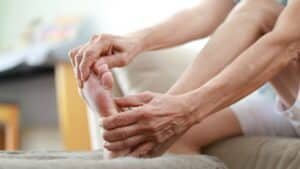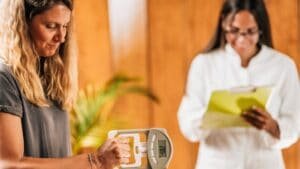
When I was still working in an office, my favorite shoes were a pair of short black cowboy boots with a 2-inch heel and a pointy toe. Wore them all the time, despite the niggling knee pain I experienced while doing so. It didn’t occur to me until much later that those shoes were partly to blame.
I was an avid hiker and had just switched from heavy, rigid-soled leather boots to much lighter boots that felt more like tennis shoes, yet still supported me well enough to carry a pack up the steepest trails without pain. I was heading in the right direction, even though I hadn’t yet heard of minimal shoes.
It wasn’t until I began my certification program to become a Restorative Exercise Specialist that I learned it isn’t natural for feet to hurt all the time. That foot pain isn’t a natural result of genetic heritage or aging. The truth is our feet are shaped (for better or worse) by the shoes we wear and the amount of time we spend in them.
Feet Are Your Foundation for Whole Body Health
With 26 bones and 33 joints in each foot, your feet have the potential to move in much more complex ways than you actually use them. This is especially true when your feet are in shoes. That’s why going barefoot in the safety of your own home is the simplest way to begin liberating your feet.
Start by taking your shoes off while reading a book or watching a movie. Wiggle your toes, point and flex a few times every hour.
Wearing shoes that let your feet be free is the easiest way to begin increasing foot mobility and strength. Minimal shoes provide a better environment for your feet, even before you begin a foot pain relief exercise program (more on this below).
“Even feet with bunions, hammer toes and plantar fasciitis can change in surprisingly good ways. Typically these changes happen slowly over time and depend on how often you’re barefoot, wearing minimal shoes, and/or doing foot exercises,” says Anya, founder of Anya’s Reviews, the comprehensive guide to looking and feeling your best in minimal shoes.
Put Your Shoes to the Test
Take a look at your favorite pair of shoes. Maybe the ones you wear most often. Or the ones that you walk and hike in. With the shoe in hand, answer these questions from Katy Bowman’s book, Simple Steps to Foot Pain Relief.
Sole
Does the sole allow natural movement of the foot, or does it make the bulk of motion come from the ankle?
Upper
Do you have to grip your toes to keep the shoe on, or does the shoe connect well to your foot?
Toe Box Width
Can your toes spread comfortably, or does a too-narrow toe box reduce spreading space? Consider this same question for your socks! You need wiggle room in them, too.
Toe Box Height
Does the front of the shoe rest on the ground, or does it curl upward, forcing the toe bones upward into a constantly extended position? (Anyone with pain in the big toe metatarsal joint – the big joint at the base of your toes – take note!)
Heel
Is the heel height affecting your other joints (feet, hips, spine, etc.) or can you maintain a truly vertical alignment?
Ponder these questions, as you take the next step, which is to place your shoe on the ground and step on top of it. If your toes do not fit within the shape of the shoe, it’s time to consider finding shoes that will let your feet be free!
Transition Slowly to Ensure Success
If you’re curious about the benefits of minimal shoes, I highly recommend taking these four steps:
Look at Reviews
Take a look at Anya’s Reviews website to find the right styles for your wardrobe, budget and foot shape. The website is packed with reviews and discount codes, plus links to free online foot health resources.
Strengthen Your Feet
Begin to gently strengthen your feet with Restorative Exercises. Here’s a free five-day program to Free Your Feet from Petra Fisher Movement. Sign up and you’ll receive a series of emails with links to short instructional videos.
Use Toe Spacers
Use toe spacers such as Happy Feet Socks that you wear while resting or lounging. Or silicone toe separators to help restore the natural movement of your toes. I use Naboso Splay. With either of these options, take it S-L-O-W-L-Y to make sustainable change.
Replace One Pair of Your Shoes at a Time
Start with walking shoes and use them just one hour at a time to get used to the differences. Here’s my video review of the latest version of a long-time personal favorite shoe for walking and hiking, the Mesa Trail from Xeroshoes.
It’s a lightweight, waterproof shoe with a flat, flexible and grippy sole that works well on all terrain. I give the 2023 model a 9 out of 10 because the toe box is a bit narrow for my foot shape. (Full disclosure: I received a free pair of Xeroshoes in exchange for my review.)
Most of all, have fun finding out about shoes that will make your feet feel great! Because fully functional feet are so important to whole body health, I offer two programs focused on foot health each Spring. Get on my mailing list for details and early bird discounts for Fix Your Feet and Walk This Way.
Let’s Have a Conversation:
Have you heard about minimal or barefoot shoes? Did you know that bunions are not hereditary, but are formed by ill-fitting shoes? Are you ready to take simple steps to relieve your foot pain?





